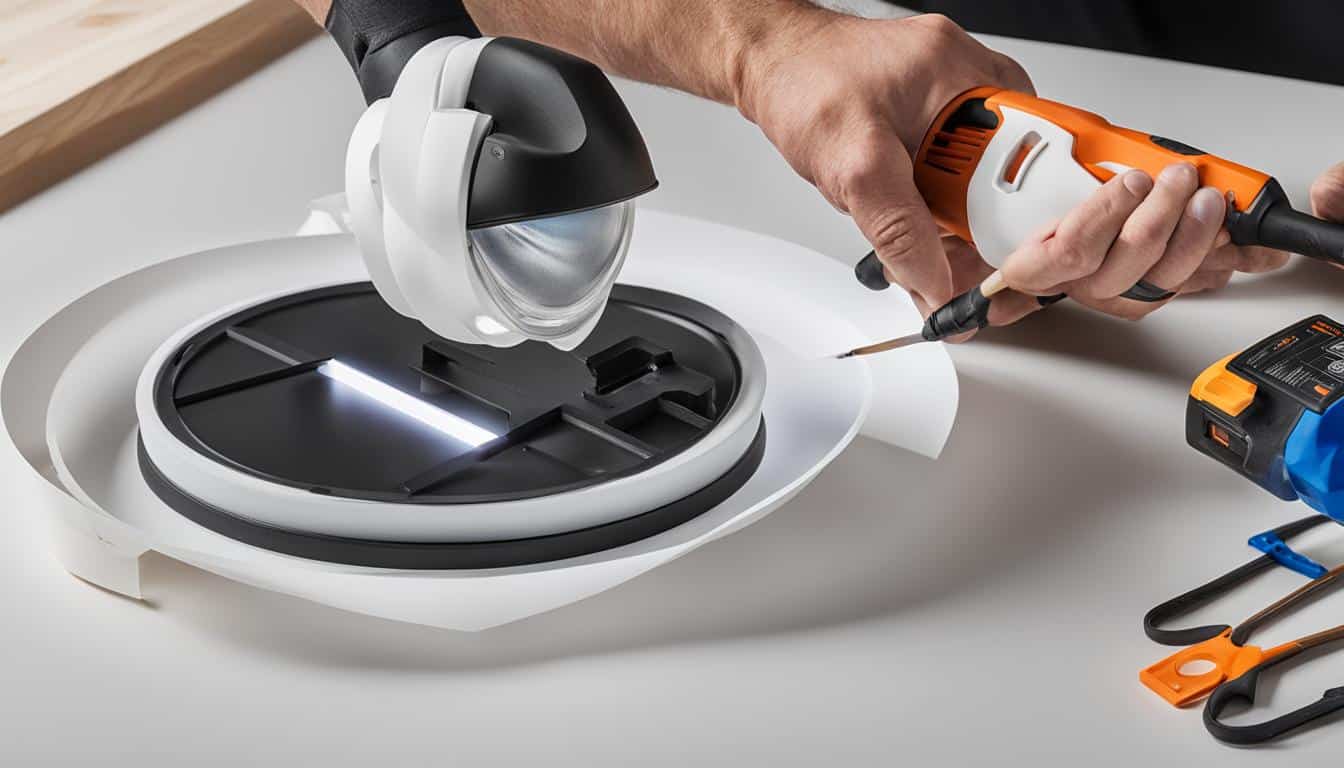If you’re looking to offer your home a modern upgrade while increasing energy efficiency, then installing LED recessed lighting is an excellent choice. In this guide, we’ll discuss a simple DIY method for how to install LED recessed lighting that will enhance both the functionality and aesthetic appeal of your living space. With careful planning and a step-by-step approach, you can achieve professional-looking results and enjoy a well-lit, inviting environment.
Key Takeaways
- LED recessed lighting is an easy DIY project for home lighting upgrades.
- Proper planning for light placement and choosing the right LED recessed lighting kits are essential.
- Understanding electrical requirements ensures the compatibility of your new lighting system.
- Step-by-step instructions make it easy to cut holes, wire, and mount LED recessed lighting fixtures.
- Maximize the benefits of LED recessed lighting through thoughtful installation and careful upkeep.
Preparing for Your LED Recessed Lighting Project
Before diving into your LED recessed lighting installation, it’s crucial to plan for success by assessing the room layout, selecting the right fixtures, and gathering the necessary tools. Follow these tips to ensure a smooth installation and a beautifully lit space.
Assessing Room Layout and Light Placement
Begin by determining the optimal LED lighting layout for your space, considering the room’s size and functionality. It’s essential to think about the desired illumination, ambiance, and how to avoid dark spots. Keep in mind that you should comply with the basic rule of having at least one LED light for every 4 to 6 square feet of the ceiling area.
Choosing the Right LED Recessed Lighting Kits
Selecting the appropriate LED fixtures is critical for a successful installation. There are two main types to consider: old-work and remodel types. IC-rated kits are necessary if your ceiling has insulation, while non-IC-rated kits should be chosen for ceilings without insulation. Additionally, consider fixtures that offer adjustable color temperatures for versatility and customizability in your space.
Gathering Essential Tools and Equipment
Before starting your installation, ensure you have the necessary tools on hand, including:
- A drywall saw or a drill with a hole-cutting attachment for cutting holes in the ceiling
- A wire stripper for preparing electrical cables
- NM-B cables for safe and reliable wiring
- Personal protective equipment, such as safety glasses and gloves
Having the right tools can help guarantee a smooth, efficient, and successful LED recessed lighting installation that will transform your living space.
How to Install LED Recessed Lighting
Installing LED recessed lighting in your home not only enhances its aesthetic appeal but also improves energy efficiency. This section will provide expert advice on choosing the best type of lighting for your space, understanding the electrical requirements, and picking the right fixtures.
Determining the Best Lighting Type for Your Space
When selecting the right LED recessed lighting for your space, it’s essential to consider the room’s function and style. Low-profile, energy-efficient LEDs with adjustable color temperatures can create a warm, inviting ambiance, while also providing ample task lighting for various activities. Choose products that are easy to install and designed for the intended environment, such as wet-rated fixtures for bathrooms or outdoor spaces.
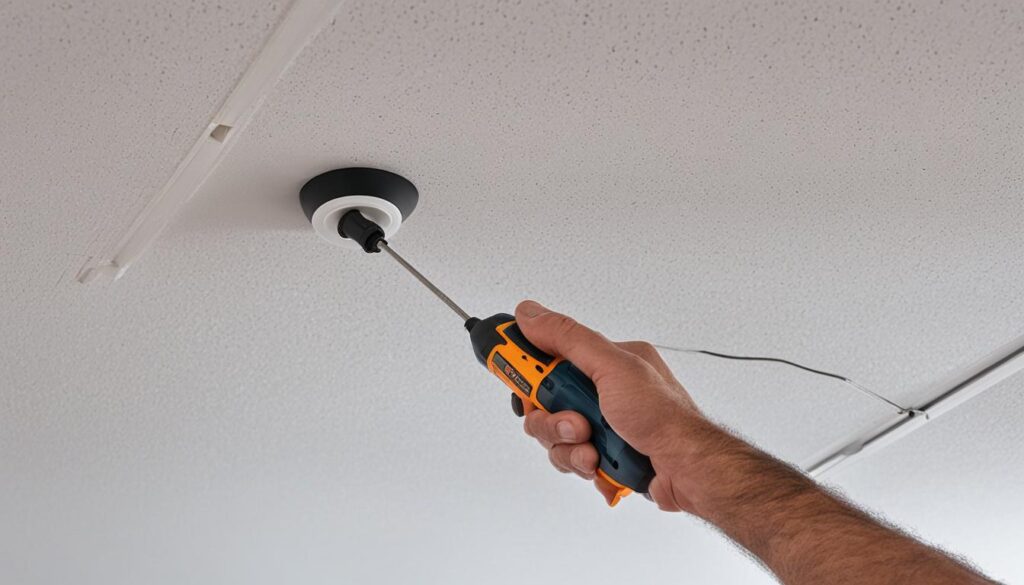
Understanding the Electrical Requirements
Before beginning the installation process, be sure to familiarize yourself with your room’s electrical needs. A standard 20-amp circuit can typically accommodate up to 12 LED recessed lights. However, it’s crucial to ensure compatibility with the room’s existing amp rating, whether you’re tapping into an existing power source or installing a new circuit. Additionally, factor in the load capacity for your home’s wiring to avoid overloading and maintain electrical safety.
Pro Tip: Consult with a licensed electrician for assistance in determining your home’s electrical capacity and ensuring a safe installation process.
Selecting Between IC-Rated and Non-IC Rated Fixtures
Another critical aspect in choosing the right LED recessed lights is deciding between IC-rated and non-IC-rated fixtures. IC-rated fixtures allow for direct contact with insulation and are suitable for insulated ceilings, whereas non-IC-rated fixtures require a clearance space between the fixture and insulation for safety reasons. Adhere to local building codes and safety regulations when making this decision.
| Fixture Type | Features | Best For |
|---|---|---|
| IC-Rated |
|
Insulated ceilings, or when insulation is present around the lighting fixture. |
| Non-IC-Rated |
|
Ceilings without insulation, when clearance can be maintained around the lighting fixture. |
With a solid understanding of electrical safety and the various fixture options for LED recessed lighting, you’re now prepared to make an informed decision and create a seamless, efficient installation process.
Step-by-Step Guide for Installing LED Recessed Lighting
Installing LED recessed lighting can be approached in two ways when it comes to cutting holes in the ceiling. Each method requires precision and caution to ensure proper installation. In this section, we will cover both options to help you choose the one that best suits your needs and skill level.
Option A: Cutting Holes in the Ceiling Manually
This method involves marking the ceiling with the provided template and carefully cutting holes using a drywall saw. Be sure to keep an eye out for any wires or obstructions in the ceiling cavity as you work. Follow the steps below for a successful manual ceiling hole cutting:
- Position the template on the desired spot, making sure it is level and aligned with nearby fixtures if applicable.
- Trace the template onto the ceiling with a pencil.
- With your drywall saw, make a small pilot hole at the center of the traced circle.
- Carefully cut along the traced line, avoiding wires or other obstructions.
- Smooth any rough edges with sandpaper if necessary.
Option B: Cutting Holes with Power Tools for Efficiency
For a more efficient process, power tools like a drill with a hole-cutting attachment can be used to cut holes in the ceiling. This method offers a faster result while still ensuring the avoidance of wiring or obstructions in the ceiling cavity. Follow the steps below for an efficient power tool-assisted recessed lighting installation:
- Attach the hole-cutting bit to your drill, ensuring it matches the required size for your LED recessed lighting fixtures.
- Mark the center of the desired hole location, making sure it aligns with nearby fixtures if applicable.
- Place the center of the bit on the marked spot and begin drilling, applying even pressure and maintaining control of the tool.
- Once the hole is cut, check for any hidden obstructions before proceeding with the installation.
- Smooth any rough edges with sandpaper if necessary.
Whichever method you decide to use for hole cutting, remember that precision and caution are crucial factors in ensuring a successful LED recessed lighting installation. By carefully preparing the ceiling, you will be able to avoid common pitfalls and make the process much smoother.
Electrical Preparations and Wiring Techniques
Properly wiring your LED recessed lighting is crucial for both functionality and safety. In this section, we will cover the steps required for running the NM-B cable from the power source to the switch and securely connecting the wires.
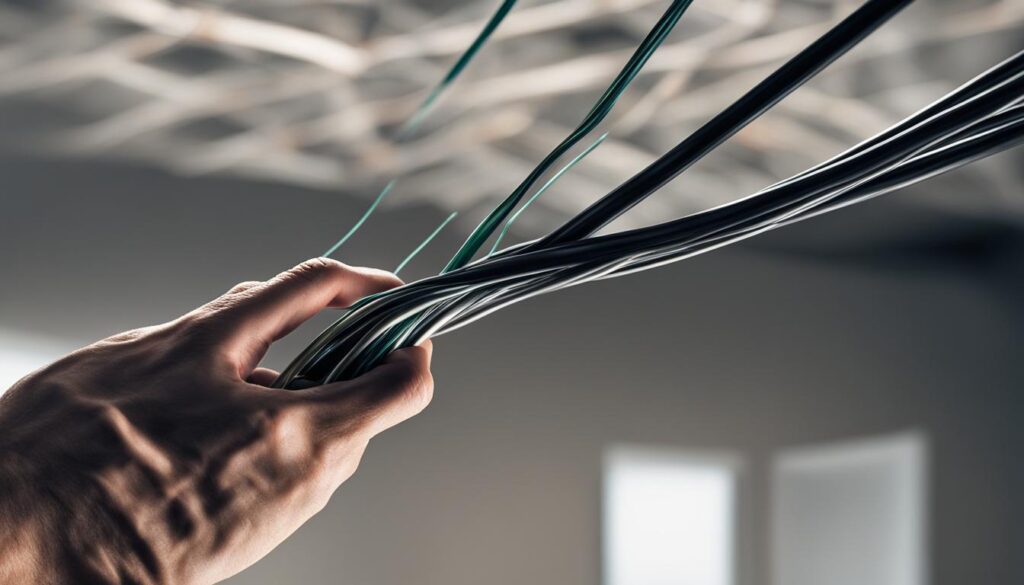
Running the NM-B Cable: From Power Source to Switch
First, disconnect any existing light fixtures. Next, run the NM-B cable from the power source to a switch box, making sure to include ample extra cable for easy wiring. Continue running the cable between each hole, maintaining a consistent flow to the last light location. By following this NM-B cable installation process, you’ll be on your way to installing a safe and functional LED recessed lighting system.
Connecting Wires: Ensuring a Secure Electrical Connection
Once the NM-B cable is run, it’s time to focus on establishing secure electrical connections. Begin by opening the light’s junction box and inserting and clamping the cables. Proceed to strip the wires and remove insulation to reveal the conductors. Connect like-colored wires with wire connectors, matching black to black, white to white, and ground to ground. Remember to carefully fold the wires into the box before sealing it. This attention to detail in electrical preparations for LED lighting will help ensure a safe and functional result.
Mounting the Recessed Lighting Fixtures
Mounting LED recessed lighting is a crucial step in completing your lighting installation. It involves carefully securing the light housing to ensure optimal performance and safety. Here, we’ll discuss everything you need to know about mounting your LED recessed lighting for a successful and polished result. We will go over the basics, starting with how to insert the fixture into the pre-cut hole, to properly securing it.
Most recessed light housings come with clips that allow you to secure the can to the ceiling by pressing against the drywall. But first, it’s essential to make sure the clips do not protrude from the can before placement. This might not only affect the flushness of the fixture but could also compromise the overall installation.
- Ensure the housing’s clips are tucked away properly inside the can.
- Position the housing flush with the ceiling, within the pre-cut hole.
- Engage the clips by pushing them up and outwards until they click into place.
- Double-check to confirm the fixture is firmly clamped and secure.
Remember: A well-secured recessed light housing creates a reliable foundation for your LED recessed lighting installation.
Following these steps will ensure your recessed lighting fixtures are safely and securely mounted to your ceiling. Not only will this bring you peace of mind, but it will also contribute to the overall durability and performance of your lighting system.
Finishing Touches: Adding the Trim and Bulbs
Once the recessed lighting fixtures are securely mounted, it’s time to add the finishing touches by installing the trim and LED bulbs. These final steps solidify the overall appearance and energy efficiency of your new lighting setup, ensuring a polished look and optimal performance.
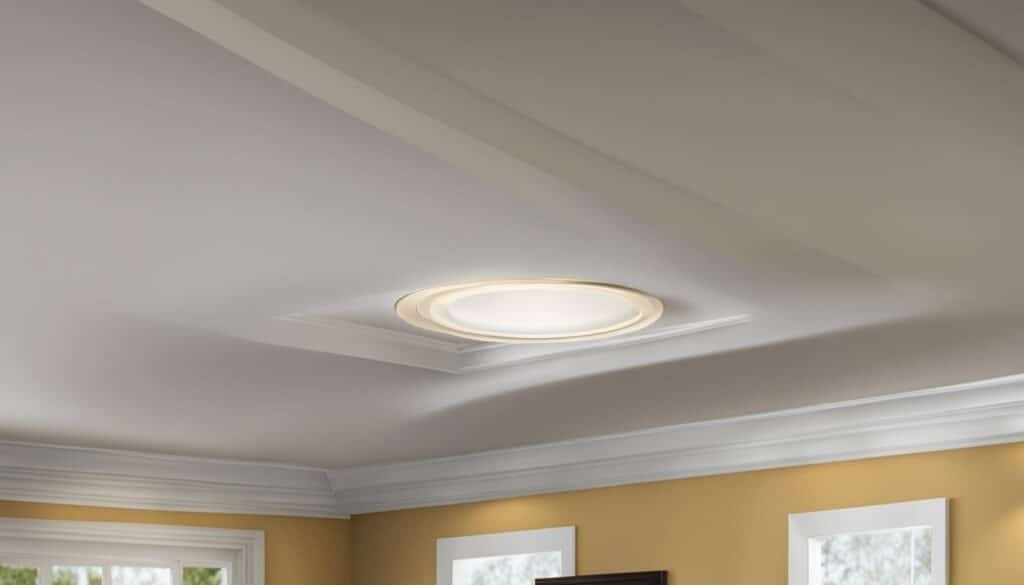
Using Coil Springs or Rod Springs to Secure Trim
Trims come in various styles and are typically mounted using either coil springs or squeezable rod springs. If you’re using coil springs, attach them to the inside of the can and then to the trim before guiding it into position. For rod springs, insert the ends into their respective holes and press the trim up into place. Properly securing the trim helps create a clean and seamless appearance.
Choosing the Right LED Bulbs for Energy Efficiency
Selecting the right LED bulbs is crucial for ensuring energy efficiency in your home. When installing energy-efficient lighting, choose LED bulbs that match the recommended wattage for your circuit to avoid overloading and potential hazards. Consider factors such as brightness, color temperature, and dimmability to create the desired ambiance and functionality in your space.
After adding the trim and bulbs to your recessed lighting, remember to power the electrical system back on and test that all lights are functioning correctly. With careful attention to detail during the installation process, you can achieve a visually appealing and energy-efficient lighting solution that complements and enhances your home’s interior design.
Best Practices for Installing LED Recessed Lighting
Adhering to best practices is key to a successful LED recessed lighting installation. This involves careful planning, ensuring a nearby power source, understanding fixture ratings, and maintaining safety standards. Using the right tools and materials can ease the process, from the choice of bulbs to the wiring equipment. Remember to wear adequate protection and safely navigate attic spaces if necessary. Following thorough preparation and mindful execution will not only make the installation smoother but will also enhance the longevity and performance of your lighting.
https://www.youtube.com/watch?v=WOK_EH5YHjM
Here are some essential DIY recessed lighting tips and LED installation techniques to consider:
- Measure and create a detailed lighting layout: Plan where each LED recessed light will be placed in the room, ensuring a balanced and functional lighting setup.
- Understand the differences between fixture ratings: Determine whether you need IC-rated or non-IC rated fixtures based on the presence of insulation and abide by proper clearance rules to maintain safety.
- Choose the right tools and materials: Utilize a drywall saw, drill with a hole-cutting attachment, wire stripper, and NM-B cable during installation. Also, remember to wear gloves, goggles, and a face mask as needed for personal protection.
- Follow electrical safety codes: Properly wire lights and ground them according to the National Electrical Code (NEC) and local regulations. Avoid overloading the circuit and always install a GFCI-protected outlet if necessary.
- Test the lights before final installation: Connect and turn on the lights temporarily to ensure they are properly functioning before securing them in place. This can save time and reduce potential frustrations during the installation process.
By adhering to the above best practices for installing LED recessed lighting, you will be well-equipped to handle a successful DIY project that enhances your home’s aesthetics and provides you with energy-efficient lighting solutions for years to come.
Common Mistakes When Installing LED Recessed Lighting
While DIY LED recessed lighting installation can be a rewarding project, it’s essential to be aware of common errors that could compromise the safety and effectiveness of your lighting. By understanding these installation errors, you can ensure that you’re safely installing recessed lights and avoiding DIY pitfalls. In this section, we’ll cover key mistakes and how to prevent them.
Avoiding Overlapping with Joists When Cutting Holes
One common mistake when installing LED recessed lighting is cutting holes that overlap with joists. This can lead to structural issues and complications during installation. To avoid this error, use a stud finder to locate and mark the joists in your ceiling. This will help you determine the proper placement for your lights and ensure a smooth installation process.

Ensuring Proper Insulation Spacing for Safety
Another critical concern while installing recessed lights is maintaining the proper insulation spacing for safety. Failing to observe safety codes regarding insulation spacing can pose fire hazards. To prevent these risks, choose IC-rated lights when installing in an insulated ceiling, as they can be safely covered with insulation. On the other hand, non-IC-rated lights require proper clearance from insulation to avoid overheating and potential fire hazards.
Always follow the manufacturer’s recommendations for insulation clearance and, if needed, consult a professional to ensure a safe and compliant installation.
Remember: Adhering to safety codes and avoiding common installation errors will result in a more effective and secure LED recessed lighting setup for your home.
Maximizing LED Recessed Lighting Benefits
By thoughtfully installing and utilizing LED recessed lighting, you can harness its numerous advantages. Energy-efficient LED technology contributes to substantial cost savings over time, while a range of color temperatures enables you to tailor the lighting to your specific preferences and needs. Moreover, installing LED recessed lights properly and in strategic locations can greatly enhance the ambiance within your home.
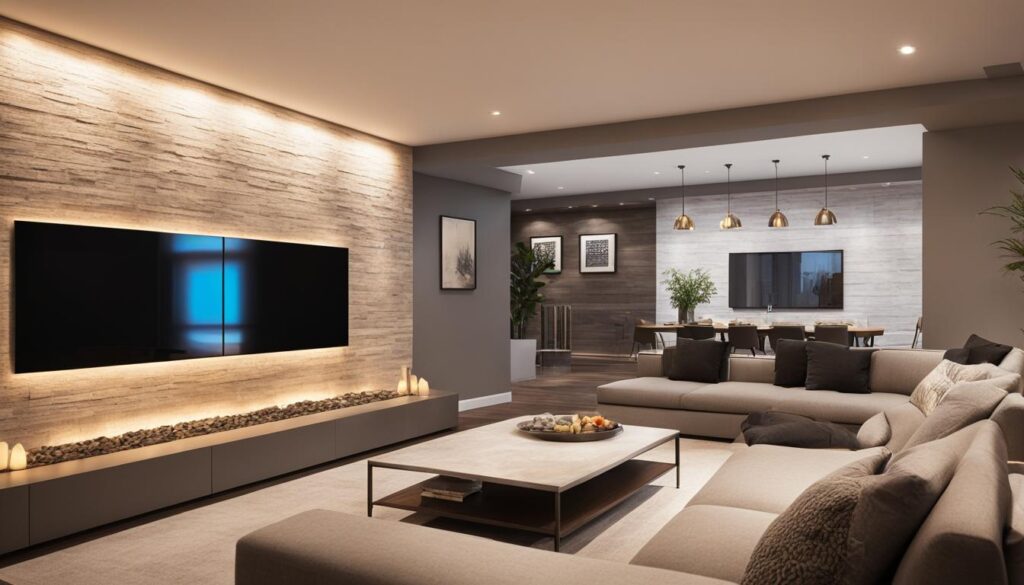
Combining these aesthetic considerations with the right product choices and installation approaches can help you tap into the full potential of LED lighting. To that end, here are some key factors to bear in mind when maximizing the benefits of LED recessed lighting:
- Choose fixtures with customizable color temperatures that suit your space.
- Opt for dimmable LEDs to control brightness and conserve energy.
- Prioritize proper spacing between lights to avoid dark spots or glare.
- Pair LEDs with compatible dimmer switches for best performance.
- Keep fixture maintenance in mind for a long-lasting setup.
To underscore the benefits of LED lighting, take a look at the following table comparing the features of traditional incandescent bulbs and LED bulbs:
| Feature | Incandescent Bulb | LED Bulb |
|---|---|---|
| Energy Efficiency | Less efficient; higher energy consumption | High-efficiency; lower energy consumption |
| Lifespan | Approx. 1,000 hours | Approx. 25,000 hours |
| Color Temperature | Usually fixed (warm yellow) | Customizable range (warm to cool) |
| Wattage | 60W | 8-10W |
By considering these factors and learning to capitalize on LED lighting’s advantages, you can effectively transform your space into a more inviting and functional environment while making a smart, energy-efficient choice.
Conclusion
As we’ve explored throughout this guide, successfully installing LED recessed lighting involves careful planning, diligent execution, and proper maintenance. By following the outlined steps and recommendations, you can transform your space with energy-efficient and aesthetically pleasing LED fixtures, ensuring both functionality and charm for years to come.
Review of Essential Steps for Successful Installation
In summary, the essential steps for a successful LED recessed lighting installation include: preparing your space and choosing the right products; cutting holes in the ceiling, ensuring they don’t intersect with any joists; wiring the lights; and mounting the fixtures. Paying close attention to detail and adhering to best practices throughout each step will ensure both optimal performance and safety for your new lighting setup.
Expert Recommendations for After-Installation Care
Once your LED recessed lights are installed, maintaining their optimal performance is the key to enjoying their full benefits. Regularly clean dust from the trim and bulbs, replace LEDs according to manufacturer recommendations, and seek expert advice for complex electrical configurations when needed. With the right approach and ongoing care, you’ll enjoy a practical and elegant lighting solution that will elevate your home’s ambiance for many years.
FAQ
What are the essential tools needed for LED recessed lighting installation?
Key tools include a drywall saw or drill with a hole-cutting attachment, a wire stripper, NM-B cable, a stud finder, and personal protective equipment.
What are the differences between IC-rated and non-IC-rated fixtures?
IC-rated fixtures are designed for use in insulated ceilings and can safely come into contact with insulation. Non-IC-rated fixtures require clearance from insulation, as they are not designed to handle direct contact with it.
How many LED recessed lights can I install on a 20-amp circuit?
A 20-amp circuit can typically handle up to 12 LED recessed lights. However, it’s important to consider the specific wattage of the bulbs and other electrical loads on the circuit.
What are common mistakes to avoid when installing LED recessed lighting?
Common mistakes include cutting holes that overlap with joists, failing to observe safety codes regarding insulation spacing, and installing bulbs with a higher wattage than recommended.
How can I maximize the benefits of LED recessed lighting?
Maximize benefits by properly placing and installing the lights, choosing energy-efficient bulbs, and utilizing the right product choices and installation approaches to create an inviting ambiance in your space.
What are some expert recommendations for after-installation care?
Maintain your LED recessed lights by cleaning dust from the trim and bulbs regularly, replacing LEDs according to manufacturer recommendations, and seeking expert advice for complex electrical configurations.

